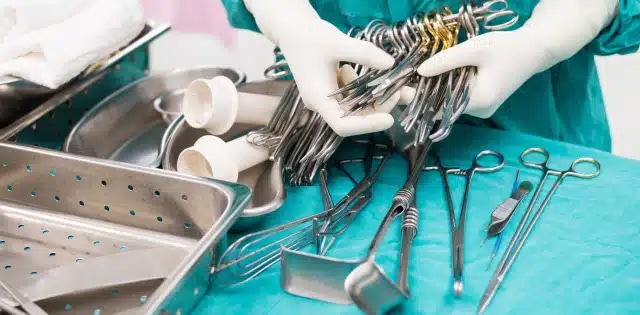
Biocompatible medical device coatings are essential for improving the performance, safety, and appearance of surgical instruments, equipment and components. In this article, we’ll explore the top medical device coatings, the benefits they provide, and how ME-92 biochrome coatings ensure optimal performance and extended product life in even the toughest environments.
Types of Medical Coatings
Antimicrobial coatings
Sterilization is a necessity for all medical procedures. Aside from maintaining a high-level cleaning process, adding antimicrobial coatings to medical devices combats bacterial contamination that often results in postoperative complications. Antimicrobial coatings can’t absorb bacteria; when exposed to bodily fluids, the coating fights against infectious microorganisms.
ME-92 coatings offer reduced bacterial adherence, thus providing easier decontamination. They maintain their surface integrity after repeated sterilization cycles through autoclave or boiling.
Anti-corrosion coatings
Corrosion is a natural process that happens when metals are exposed to the environment. When metal is in contact with oxygen, it oxidizes (rusts). Corrosion slowly changes the structure of metal instruments leading to breakdown, brittleness, and contamination.
Anti-corrosion coating extends the life of medical devices and minimizes contamination of surgical instruments. ME-92 coating technology arrests corrosion from sterilization and laser marking, while maintaining a pristine appearance.
Hydrophilic coatings
Some medical devices and instruments are in contact with liquids. Because of their role, they need to possess wettability—the liquid must maintain contact with the surface of devices or instruments. Hydrophilic coating helps device surfaces bind water. Depending on the use of a medical instrument or device, hydrophilic surface coatings can be permanently or transiently hydrophilic.
Hydrophobic coatings
Hydrophobic coatings, like ME-92® and AL-COAT®, are designed to repel fluids including water, blood, and urine. This characteristic also provides a self-cleaning ability and thus reduces risks of contamination and infections. There are even superhydrophobic coatings which have extreme water repellency.
Lubricant coatings
Devices inserted into living tissue, such as needles during blood draw, require a lubricant coating to reduce static and kinetic friction. These coatings don’t expand and flake when in contact with fluids. Furthermore, because healthcare professionals use lubricants to insert inorganic devices and instruments into patients’ tissues, it’s imperative that these coatings fulfill specific biocompatibility and hemocompatibility standards. However, it’s crucial to acknowledge that these coatings are novel, and their effectiveness remains limited thus far. As they become less effective due to the harsh environment of the human body, the only option is to remove and replace the medical device.
Anti-reflection coatings
Anti-reflection coatings are used in many medical instruments, such as microscopes and endoscopes, to reduce glare and improve visibility. During surgical procedures, such as laparoscopy and endoscopy, clear visibility of the surgical site is essential for the success of the operation. Without anti-reflection coatings, however, glare from the instrument’s light source can make it difficult for the surgeon to see what they are doing, increasing the risk of mistakes and complications. Anti-reflective coatings, such as ME-92® chromium coating, reduce glare and improve image clarity and contrast, enabling surgeons to see fine details and make precise adjustments that the procedure requires.
Chemical resistance coatings
Chemical resistance coatings are a valuable tool for protecting medical devices, surgical equipment, and other components from the damaging effects of chemicals, including those required for repeated sterilization cycles. By providing a barrier between the surface of the medical device and the chemicals, these coatings prevent corrosion and other forms of damage that can compromise the performance, safety, and appearance of the device. This is important because the appearance of medical devices can affect both the confidence of the professionals using them and the perception of cleanliness by patients receiving medical care. Chemical resistance coatings like those from ME-92 also help to extend the lifespan of medical devices and equipment, reducing the need for costly repairs and replacements.
Thermal barrier coatings
Associated with the aerospace industry, thermal barrier coatings are becoming the norm in medicine. These coatings provide thermal insulation to medical device surfaces and can be applied only to parts that require such protection. ME-92 chromium coatings can be used in a wide temperature range, from –70 °F to 1000 °F (–57 °C to 427 °C), providing optimal performance in challenging environments.
Wear-resistant coatings
Wear-resistant coatings applied to medical instruments offer surface hardness and a scratch-resistance surface. This appearance is an often an overlooked advantage—a wear-resistant coating that eliminates fretting, galling, and spalling will not only provide the instruments’ longevity, but will also preserve their look.
ME-92: Proven solutions from a trusted partner
The first biochrome coating to perform and pass the Tripartite Guidelines Testing for Biocompatibility, ME-92 coatings reduce bacterial adherence, facilitate easier cleaning and decontamination, and maintain the surface integrity after repeated sterilization cycles. ME-92® and AL-COAT® coatings have also passed the biocompatibility requirements for the current ISO 10993 standard. Our mission is to empower medical professionals with functional coatings that enhance the overall performance of surgical instruments and devices, while meeting our customers’ expectations of quality and affordability.